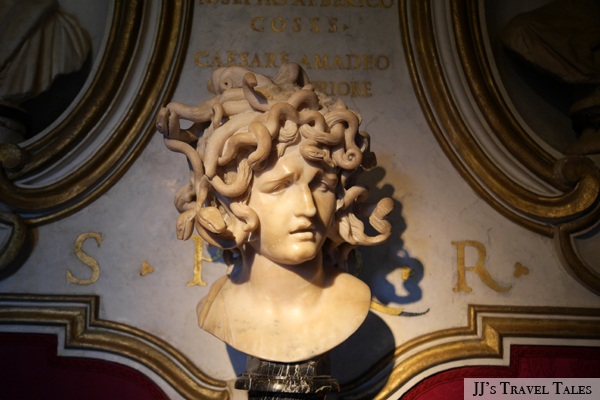In every city, there is a low-profile museum that is a real gem. In Rome, the Capitoline museum housing Roman artifacts is the one. It is my favorite museum in Rome. It features lots of iconic pieces, great presentation, and the best museum visit experience you can have. Photography is allowed, that's really a big plus. There was no line and the museum was not crowded in the morning when I was there in late September. I really enjoyed my visit. It was so peaceful and relaxing in the museum, and that is the ideal condition to browse artwork.
When I stepped into the courtyard, the big foot just sat there screaming for attention. How fun is this thing? Do you see a face in the background? I believe that's the head of the colossal statue of Roman Emperor Constantine I. The fragmental big foot also belongs to the statue of Constantine I.
The Capitoline Wolf is a bronze sculpture of a she-wolf nursing twin babies, inspired by the Roman mythology of the founding of Rome. She-wolf is the symbol of Ancient Rome from the 5th century BC. The twins, Romulus and Remus, were added to the Etruscan bronze she-wolf in the 15th century.
This one is Bernini's interpretation of Medusa. In Greek mythology, Medusa is a female monster with snakes in place of hair. Looking into her eyes would turn spectators to stone. Bernini's Medusa doesn't appear to be that sinister. She looks stressed out.
Leone che azzanna il cavallo shows a lion attacking a horse. It represented the power and viciousness of Rome. This was the most iconic image of Rome before the she-wolf became the symbol of Rome. From this sculpture, you can see the Roman way of thinking.
The Bronze Equestrian Statue of Marcus Aurelius in Piazza del Campidoglio is a copy. This is the original dating from 2AD. The emperor is shown with arm outstretched just like the pose in the relief of 'conquest and clemency' seen in the beginning of this post.
The above is the rippling bronze statue of Hercules, brandishing his club and holding the golden apple stolen from Hesperides.
The marble statue of Heracles Fighting is from an original of the end of the 4th century BC. Heracles, the son of Zeus , was the greatest hero in Greek mythology. In Rome and the modern West, he is recognized as Hercules. The Romans adopted the Greek version of Heracles’ life but added some tales of their own.
The Cini Gallery holds the porcelain collection donated by Count Francesco Cini in 1881 and other donations of European and Oriental porcelain.














No comments:
Post a Comment